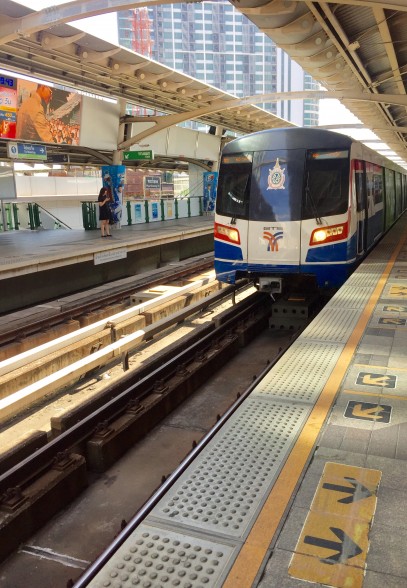To teach English in Thailand it’s not only good to be prepared for the classroom, but also for the culture you’ll be joining. Good thing, we’ve got Teacher Becca to share her experience and great tips:
Let’s start with the facts. Bangkok is the largest and most populated city in Thailand. It is *the* city.
As the capital, there are numerous cultural attractions to keep you busy.
Let’s do Bangkok by the numbers:
• City population is roughly 8 million
• The city spans 600 square miles, give or take
• It was founded as the capital in 1782
• There are just 2 lines on the Bangkok Transit System,
making it easy to find your way
• Bangkok is technically the world’s hottest city, with a record high of 40 degrees. Thankfully it averages around 28. Brr.
• The city boasts the world’s biggest Chinatown
• There are exactly 169 characters in Bangkok’s official name, which is…wait for it…
Krungthepmahanakhon Amonrattanakosin Mahinthara Yutthaya Mahadilok Phop Noppharat Ratchathani Burirom Udom Ratchaniwet Mahasathan Amonphiman Awatansathit Sakkathattiya Witsanukamprasit
Which translates to…
the city of angels, great city of immortals, magnificent city of the nine gems, seat of the king, city of royal palaces, home of gods incarnate, erected by Visvakarman at Indra’s behest.
Tourism in Bangkok
Domestic and international tourism is the lifeblood that pumps through the veins of Bangkok. On average, Bangkok sees close to 30 million domestic visitors, and over 10 million international visitors every year.
That amounts to countless Baht brought in through both the official channels, and the street deals that occur regularly in the shopping, food, nightlife and entertainment sectors.
Don’t miss!
So, there is more than enough for a weekend getaway in Bangkok. If you are missing some of the creature comforts from the West, then head straight for the BTS, known as the Sky Train, and get off at the Siam Center stop.
There you will find the famed MBK Center, which can be simply described as malls on malls on malls. It is the place to be for shopping, dining, and entertainment, ranging from high-end to boutique to street vendors.
A simple trip to the movies (in English with Thai subtitles- they know their audience!), and some familiar Western chain restaurants and shops serves as a nice air-conditioned escape from the outside world.
For the Culture Vultures
For a taste of the arts scene in the capital city, the Bangkok Arts and Culture Center is an absolute must. Free admission and the Guggenheim-esque spiral design makes this part-gallery, part-community center attraction fun for everyone.
Don’t forget to save some time for the numerous temples and of course a visit to the Grand Palace. With the king’s passing in October, it is a fascinating time to see the grounds.
I suggest visiting the Wat Pho, just down the street, where for just 100 Baht entrance fee you get a bottle of water, a photo opportunity with the famed reclining golden Buddha, and plenty of time to marvel at the colorfully ornate decor of the temple grounds.
However you decide to spend your free time, Bangkok can guarantee something to please the eyes, despite the inescapable layer of smog.
Pro Tips:
• Park It:
Due to the traffic congestion and subsequent pollution, it is important to seek out the admittedly scarce green space.
Lumphini Park is a personal favorite and one of the biggest in the city, perfect for a relaxing afternoon post sightseeing.
• BTS, also known as Sky Train:
It can be tricky to get a taxi driver to turn on the meter, and with some of the worst traffic in the world, the BTS is a great alternative.
Payments can only be made in coin, but helpful English-speaking tellers are plentiful in the stations. A single journey will cost you between 15 and 52 Baht depending on how many stops, with a day pass at 130 Baht. Grab one of the free maps from the stations and you will be good to go.
• The Maew’s Meow:
“Cat” is one of the easier (one of the only if we’re being honest) Thai words for me to remember, and Thailand is full of them!
If you want to check out one of the famed Cat Cafés, of which Bangkok has 11, then I suggest the Caturday Café.
It’s walking distance from the shopping district and BACC, and serves Western food.
Then of course there’s the Hello Kitty Café and Unicorn Café but I don’t want to bore you with that right meow…
Until next time,
Teacher Becca
Are you inspired to jet off to Bangkok? Don’t forget that i-to-i not only helps you teach English in Thailand, but offers supported travel.
You could be part of the next Thailand adventure. Visit our Paid Thailand TEFL Internship page for full details.







